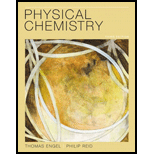
(a)
Interpretation: The value of
Concept Introduction: All substances can mainly exist in three phases; solid, liquid and gases. These three phases can convert into each other by the application of temperature and pressure such as by heating of solid, it converts to liquid and then gaseous
The enthalpy change during the fusion of solid to liquid is called as enthalpy of fusion that is denoted as
Clausius - Clapeyron equation purposed the relationship between the pressure and temperature for conditions of equilibrium between two phases; vapor and solid for sublimation or solid and liquid for fusion.
Here, P is pressure, T is temperature, R is Universal gas constant and
(b)
Interpretation: The value of
Concept Introduction: All substances can mainly exist in three phases; solid, liquid and gases. These three phases can convert into each other by the application of temperature and pressure such as by heating of solid, it converts to liquid and then gaseous state of matter.
The enthalpy change during the fusion of solid to liquid is called as enthalpy of fusion that is denoted as
Clausius - Clapeyron equation purposed the relationship between the pressure and temperature for conditions of equilibrium between two phases; vapor and solid for sublimation or solid and liquid for fusion.
Here, P is pressure, T is temperature, R is Universal gas constant and
(c)
Interpretation: The value of normal boiling point and
Concept Introduction: All substances can mainly exist in three phases; solid, liquid and gases. These three phases can convert into each other by the application of temperature and pressure such as by heating of solid, it converts to liquid and then gaseous state of matter.
The enthalpy change during the fusion of solid to liquid is called as enthalpy of fusion that is denoted as
Clausius - Clapeyron equation purposed the relationship between the pressure and temperature for conditions of equilibrium between two phases; vapor and solid for sublimation or solid and liquid for fusion.
(d)
Interpretation: The triple point temperature and pressure for carbon tetrachloride which melts at 250 K needs to be determined.
Concept Introduction: All substances can mainly exist in three phases; solid, liquid and gases. These three phases can convert into each other by the application of temperature and pressure such as by heating of solid, it converts to liquid and then gaseous state of matter.
The enthalpy change during the fusion of solid to liquid is called as enthalpy of fusion that is denoted as
Clausius - Clapeyron equation purposed the relationship between the pressure and temperature for conditions of equilibrium between two phases; vapor and solid for sublimation or solid and liquid for fusion.
Want to see the full answer?
Check out a sample textbook solution
Chapter 8 Solutions
Physical Chemistry Plus Mastering Chemistry With Etext -- Access Card Package (3rd Edition) (engel Physical Chemistry Series)
- 7.5 1.93 2.05 C B A 4 3 5 The Joh. 9 7 8 1 2 7.5 7.0 6.5 6.0 5.5 5.0 4.5 4.0 3.5 3.0 2.5 2.0 1.5 1.0 ppm 9 7 8 0.86 OH 10 4 3 5 1 2 7.5 7.0 6.5 6.0 5.5 5.0 4.5 4.0 3.5 3.0 2.5 2.0 1.5 1.0 ppm 9 7 8 CI 4 3 5 1 2 7.0 6.5 6.0 5.5 5.0 4.5 4.0 3.5 3.0 2.5 2.0 2.21 4.00 1.5 2.00 2.07 1.0 ppm 2.76arrow_forwardAssign the functional group bands on the IR spectra.arrow_forwardFind the pH of a 0.120 M solution of HNO2. Find the pH ignoring activity effects (i.e., the normal way). Find the pH in a solution of 0.050 M NaCl, including activityarrow_forward
- Please help me answer these three questions. Required info should be in data table.arrow_forwardDraw the major organic substitution product or products for (2R,3S)-2-bromo-3-methylpentane reacting with the given nucleophile. Clearly drawn the stereochemistry, including a wedged bond, a dashed bond and two in-plane bonds at each stereogenic center. Omit any byproducts. Bri CH3CH2O- (conc.) Draw the major organic product or products.arrow_forwardTartaric acid (C4H6O6) is a diprotic weak acid. A sample of 875 mg tartaric acid are dissolved in 100 mL water and titrated with 0.994 M NaOH. How many mL of NaOH are needed to reach the first equivalence point? How many mL of NaOH are needed to reach the second equivalence point?arrow_forward
- Including activity, calculate the solubility of Pb(IO3)2 in a matrix of 0.020 M Mg(NO3)2.arrow_forwardIncluding activity coefficients, find [Hg22+] in saturated Hg2Br2 in 0.00100 M KBr.arrow_forwardIncluding activity, calculate the pH of a 0.010 M HCl solution with an ionic strength of 0.10 M.arrow_forward
- Can I please get the graph 1: Concentration vs. Density?arrow_forwardOrder the following series of compounds from highest to lowest reactivity to electrophilic aromatic substitution, explaining your answer: 2-nitrophenol, p-Toluidine, N-(4-methylphenyl)acetamide, 4-methylbenzonitrile, 4-(trifluoromethyl)benzonitrile.arrow_forwardOrdene la siguiente serie de compuestos de mayor a menor reactividad a la sustitución aromática electrofílica, explicando su respuesta: ácido bencenosulfónico, fluorobenceno, etilbenceno, clorobenceno, terc-butilbenceno, acetofenona.arrow_forward
 ChemistryChemistryISBN:9781305957404Author:Steven S. Zumdahl, Susan A. Zumdahl, Donald J. DeCostePublisher:Cengage Learning
ChemistryChemistryISBN:9781305957404Author:Steven S. Zumdahl, Susan A. Zumdahl, Donald J. DeCostePublisher:Cengage Learning ChemistryChemistryISBN:9781259911156Author:Raymond Chang Dr., Jason Overby ProfessorPublisher:McGraw-Hill Education
ChemistryChemistryISBN:9781259911156Author:Raymond Chang Dr., Jason Overby ProfessorPublisher:McGraw-Hill Education Principles of Instrumental AnalysisChemistryISBN:9781305577213Author:Douglas A. Skoog, F. James Holler, Stanley R. CrouchPublisher:Cengage Learning
Principles of Instrumental AnalysisChemistryISBN:9781305577213Author:Douglas A. Skoog, F. James Holler, Stanley R. CrouchPublisher:Cengage Learning Organic ChemistryChemistryISBN:9780078021558Author:Janice Gorzynski Smith Dr.Publisher:McGraw-Hill Education
Organic ChemistryChemistryISBN:9780078021558Author:Janice Gorzynski Smith Dr.Publisher:McGraw-Hill Education Chemistry: Principles and ReactionsChemistryISBN:9781305079373Author:William L. Masterton, Cecile N. HurleyPublisher:Cengage Learning
Chemistry: Principles and ReactionsChemistryISBN:9781305079373Author:William L. Masterton, Cecile N. HurleyPublisher:Cengage Learning Elementary Principles of Chemical Processes, Bind...ChemistryISBN:9781118431221Author:Richard M. Felder, Ronald W. Rousseau, Lisa G. BullardPublisher:WILEY
Elementary Principles of Chemical Processes, Bind...ChemistryISBN:9781118431221Author:Richard M. Felder, Ronald W. Rousseau, Lisa G. BullardPublisher:WILEY





